|
|
|
Sort Order |
|
|
|
Items / Page
|
|
|
|
|
|
|
| Srl | Item |
| 1 |
ID:
122532
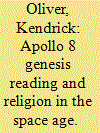

|
|
|
|
|
| Publication |
2013.
|
| Summary/Abstract |
Between January 1969 and the summer of 1975, NASA received over eight million letters and petition signatures supporting the right of American astronauts to free religious expression in space. Prompted by Madalyn Murray O'Hair's complaints about the reading of Genesis during the flight of Apollo 8, the petition campaign points to the complex ambivalent relationship between religious Americans and their nation's space program. The Genesis reading had provided reassurance that the program, with its secular motivations, its instrumental culture, and its designs upon God's very heavens, was not hostile to faith. But what if NASA now yielded to O'Hair? The petitions flowed in the eschatological anxiety that the sacred space of the skies might be cleared of Christian speech.
|
|
|
|
|
|
|
|
|
|
|
|
|
|
|
|
| 2 |
ID:
122526
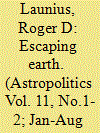

|
|
|
|
|
| Publication |
2013.
|
| Summary/Abstract |
What if we viewed the history of human spaceflight somewhat less through the lens of Cold War politics, which admittedly was central to the race to the Moon, but more as an expression of what might be called a religion of spaceflight? There seems to be a deeply religious quality to advocacy for the investment in and support for human space exploration, lending to the endeavor of a "higher purpose" that helps to explain both the generous nature of the actual investment and the ultimate unwillingness of Americans to eviscerate space budgets despite less than full support for space exploration. This article examines religious conceptions as a means of analyzing what might be termed a "space gospel." I lay out here the proposition that human spaceflight may be viewed as a religion with similar attributes to those present in mainstream religious denominations. This approach to exploring the history of human spaceflight offers a different and useful frame of understanding that broadens basic conceptions about this aspect of the human past.
|
|
|
|
|
|
|
|
|
|
|
|
|
|
|
|
| 3 |
ID:
122531
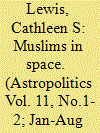

|
|
|
|
|
| Publication |
2013.
|
| Summary/Abstract |
The first men to fly into space precipitated comments about religion and God, but for most of the history of human spaceflight these comments related to Christianity. As International Space Station partners recruit spacefarers from Islamic countries, they face new religious challenges. Islam is distinct from other large monotheistic religions by virtue of the fact that Muslim worship practices require routine attention to Earth geography and astronomy. It is a vantage point that changes in low Earth orbit. Recent Muslim astronauts and cosmonauts have led the way in adapting religious practices to their position above the Earth.
|
|
|
|
|
|
|
|
|
|
|
|
|
|
|
|
| 4 |
ID:
122524


|
|
|
|
|
| Publication |
2013.
|
| Summary/Abstract |
The Overview Effect by Frank White (1987) aims at creating a "philosophy of space" for the American space program and the pro-space movement. As such, it has become something of a classic. It describes an evolutionary process set in motion by the first astronauts venturing into space and seeing Earth from an extraterrestrial perspective. According to White, this process is guided by universal forces and ultimately leads to the universe becoming intelligent and self-aware. However, The Overview Effect has not only found readers among space enthusiasts; it has also been cited in various literature, some of it academic and dealing with historical and societal aspects of spaceflight. This article examines White's overview thesis and demonstrates that it is fundamentally religious. Thus, evidence of the presence of religion in the American pro-space movement is presented, while at the same time the use of White's thesis in academic literature is put into question.
|
|
|
|
|
|
|
|
|
|
|
|
|
|
|
|
| 5 |
ID:
122527
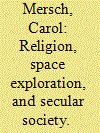

|
|
|
|
|
| Publication |
2013.
|
| Summary/Abstract |
This article concerns the efforts of Reverend John M. Stout and the Apollo Prayer League to land microfilm copies of the Christian Bible on the lunar surface during the Apollo era. The efforts of Stout, a NASA information scientist and industrial chaplain who orchestrated the years-long undertaking, underscored manned spaceflight not only as a technological and geopolitical achievement, but as a collective spiritual quest. The venture was countered at the time by the renowned head of the American Atheists, Madalyn Murray O'Hair, who insisted that religious artifacts and observances had no place on state-sponsored, taxpayer-funded missions. Stout believed that the astronauts themselves had rights guaranteed by the First Amendment. The rancorous debate between Stout and O'Hair, which was played out in the media, laid bare the innate conflict between personal religious freedom and the specter of state-sponsored religion in a secular society making its first expeditions into deep space.
|
|
|
|
|
|
|
|
|
|
|
|
|
|
|
|
| 6 |
ID:
122529
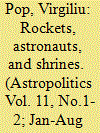

|
|
|
|
|
| Publication |
2013.
|
| Summary/Abstract |
This article examines the relationship between space exploration and sacred visual art, demonstrating that religious iconography and church architecture evolved by assimilating humankind's entry into the physical heavens as a living parable. This is proven by the presence of space exploration imagery within places of worship-from a church building inspired by a payload fairing to inclusion of space exploration milestones as historical landmarks, from astronauts being chosen as depictions of Christian virtues to lunar material being included in church windows, and from a space shuttle being painted on a Christian Orthodox church wall to a space hotel being represented on a Buddhist temple. The incidences of space themes in religious visual arts, as well as the fervor of reception, vary nonetheless among denominations.
|
|
|
|
|
|
|
|
|
|
|
|
|
|
|
|
| 7 |
ID:
122525


|
|
|
|
|
| Publication |
2013.
|
| Summary/Abstract |
A product of science, religion, and national culture, cosmism is reflected in academic and popular views about our place in the universe, space exploration, and human destiny. Although linked historically to the Russians, cosmism captures many aspects of American thinking about space. The present comparison shows that prophets, prophecies, striving for perfection, utopian visions, and hopes for salvation are evident in both Russian and American thought, but that there are also differences. Geert Hofstede's cross-cultural research on national values-power distance, individualism, masculinity, and uncertainty avoidance-is useful for understanding Russian-American differences. Russian acceptance of power inequalities, collectivism, concern for group welfare, and aversion to uncertainty lead to constellations of beliefs and emotions about spaceflight that differ from those bred by American egalitarianism, individualism, obsession with personal achievement, and acceptance of uncertainty. Both Russian and American thinking include occult and paranormal phenomena, but Americans have been more reluctant to assimilate such influences within mainstream science. As a concept, American cosmism captures the occasional blurring of the lines between religion and science in discussions of humanity's place in the universe and future in space.
|
|
|
|
|
|
|
|
|
|
|
|
|
|
|
|
| 8 |
ID:
122530


|
|
|
|
|
| Publication |
2013.
|
| Summary/Abstract |
Instances of religious expression by astronauts aboard NASA spacecraft present a unique encounter between American space policy and legal jurisprudence. The agency must adjudicate between its reticence to restrict astronauts' religious action with its responsibility to protect the constitutional separation between church and state. Though NASA won a suit filed by an atheist activist in 1969, it has not always taken proper consideration of the dangers of astronauts' religious expression. As it seeks a sustained human presence in outer space, NASA should form a policy regarding its responsibility to provide religious accommodation for current and future astronauts.
|
|
|
|
|
|
|
|
|
|
|
|
|
|
|
|
|
|
|
|
|